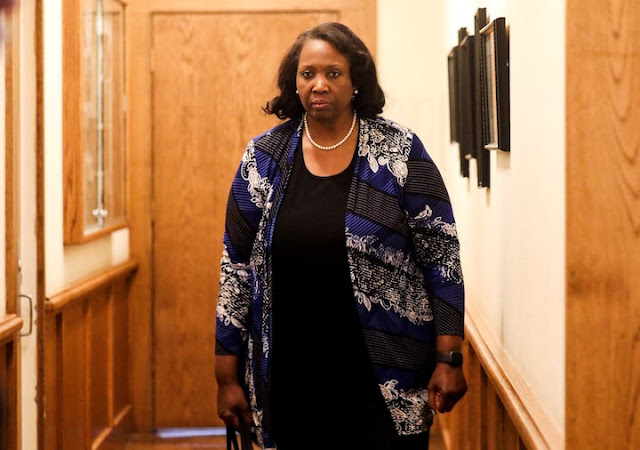Washington, D.C., September 10, 2025 – A U.S. federal judge has issued a temporary restraining order preventing former President Donald Trump from removing Federal Reserve Governor Lisa Cook from her position, marking a significant legal setback for Trump’s efforts to exert influence over the central bank. The ruling, delivered on September 9, 2025, by U.S. District Judge Jane Thompson in Washington, D.C., underscores the delicate balance of power between the executive branch and the independence of the Federal Reserve, an institution critical to the stability of the U.S. economy.
The decision stems from a lawsuit filed by Governor Cook, who challenged Trump’s attempt to oust her from the Federal Reserve Board of Governors, where she has served since her appointment in 2022. The legal battle highlights ongoing tensions surrounding the autonomy of the Federal Reserve, a cornerstone of U.S. monetary policy, and raises questions about the extent to which a president can influence the central bank’s leadership. This article explores the details of the ruling, the background of the dispute, the legal arguments presented, and the broader implications for the Federal Reserve’s independence and the U.S. economy.
Background of the Dispute
Lisa Cook, an accomplished economist and the first Black woman to serve as a Federal Reserve Governor, was appointed by President Joe Biden in 2022 for a term set to expire in 2028. Her tenure has been marked by her focus on economic disparities, labor market dynamics, and the impact of monetary policy on underrepresented communities. Cook’s academic credentials, including her work as a professor at Michigan State University and her prior role at the White House Council of Economic Advisers, have made her a prominent figure in economic policy circles.
The controversy began when former President Trump, who returned to the White House in January 2025 after winning the 2024 presidential election, announced his intention to remove Cook from her position. Trump’s rationale, as articulated in public statements and legal filings, centered on his belief that Cook’s economic views were misaligned with his administration’s priorities, particularly his push for lower interest rates and a more aggressive approach to stimulating economic growth. Trump has long been critical of the Federal Reserve, frequently accusing it of mismanaging monetary policy during both his first term (2017–2021) and his current administration.
Trump’s attempt to remove Cook was grounded in his interpretation of executive authority, which he argued granted him the power to dismiss Federal Reserve governors at his discretion. However, the Federal Reserve’s structure, established under the Federal Reserve Act of 1913, is designed to insulate the central bank from political interference. Governors are appointed for 14-year terms, staggered to prevent any single president from exerting undue influence over the board. The law allows for removal only “for cause,” a term that has been interpreted to require evidence of misconduct, inefficiency, or neglect of duty—none of which were explicitly cited in Trump’s attempt to oust Cook.
The Legal Battle
On August 15, 2025, Cook filed a lawsuit in the U.S. District Court for the District of Columbia, seeking to block Trump’s attempt to remove her from the Federal Reserve Board. Her legal team argued that the president’s actions violated the Federal Reserve Act, which explicitly protects governors from arbitrary dismissal. The lawsuit contended that Trump’s move was politically motivated and lacked any legitimate “cause” as required by law. Cook’s attorneys further argued that her removal would undermine the Federal Reserve’s independence, setting a dangerous precedent for future administrations to exert control over monetary policy.
In response, Trump’s legal team asserted that the president possesses broad authority to manage the executive branch, including the ability to remove officials whose policy positions conflict with the administration’s agenda. They cited historical precedents, such as the removal of government officials in other agencies, and argued that the Federal Reserve’s unique status does not entirely shield its governors from presidential oversight. The administration also claimed that Cook’s voting record on monetary policy decisions, which included support for interest rate hikes to curb inflation, was detrimental to the economic interests of the United States.
Judge Thompson, a seasoned jurist known for her meticulous approach to constitutional law, issued the temporary restraining order on September 9, 2025, after a series of hearings that drew significant attention from legal scholars, economists, and policymakers. In her ruling, Thompson emphasized that the Federal Reserve’s independence is a critical pillar of the U.S. financial system, designed to ensure that monetary policy decisions are made based on economic data and analysis rather than political pressures. She noted that Trump’s stated reasons for seeking Cook’s removal did not meet the legal threshold of “for cause” under the Federal Reserve Act.
“The Federal Reserve’s structure reflects a deliberate choice by Congress to limit political influence over monetary policy,” Thompson wrote in her 20-page opinion. “Absent clear evidence of misconduct or dereliction of duty, the president’s authority to remove a Federal Reserve governor is constrained. The plaintiff has demonstrated a likelihood of success on the merits of her claim, and a temporary restraining order is warranted to preserve the status quo.”
The ruling is not a final decision on the merits of the case, which is expected to proceed to a full trial in the coming months. However, it temporarily prevents Trump from removing Cook from her position, allowing her to continue serving on the Federal Reserve Board while the legal process unfolds.
Implications for the Federal Reserve’s Independence
The dispute over Cook’s removal is the latest chapter in a long-running debate about the balance of power between the presidency and the Federal Reserve. The central bank’s independence is considered essential to its ability to make impartial decisions about interest rates, money supply, and other monetary policy tools that influence inflation, employment, and economic growth. By insulating the Federal Reserve from short-term political pressures, Congress sought to ensure that monetary policy serves the long-term interests of the economy rather than the immediate goals of any single administration.
Historically, presidents have expressed frustration with the Federal Reserve’s policies, particularly when they conflict with their economic agendas. During his first term, Trump repeatedly criticized then-Federal Reserve Chairman Jerome Powell, whom he appointed in 2018, for raising interest rates, which Trump argued stifled economic growth. In 2019, Trump even suggested that he had the authority to demote or fire Powell, though no formal action was taken. The current dispute over Cook represents a more direct challenge to the Federal Reserve’s autonomy, as it involves an attempt to remove a sitting governor rather than merely criticizing the central bank’s leadership.
Legal experts warn that a successful effort to remove Cook without clear justification could erode the Federal Reserve’s independence, potentially leading to a politicization of monetary policy. Such a shift could undermine public and investor confidence in the central bank’s ability to act impartially, with ripple effects across financial markets. “The Federal Reserve’s credibility rests on its ability to operate free from political interference,” said Sarah Mitchell, a professor of constitutional law at Georgetown University. “If presidents can remove governors at will, it risks turning the Fed into an extension of the White House, which could destabilize the economy.”
Economic and Political Context
The legal battle unfolds against a backdrop of heightened economic uncertainty. In 2025, the U.S. economy faces a complex mix of challenges, including persistent inflation, rising interest rates, and concerns about a potential slowdown in growth. The Federal Reserve, under Chairman Powell’s leadership, has maintained a cautious approach to monetary policy, balancing the need to control inflation with the risk of triggering a recession. Cook, as one of seven governors on the Federal Reserve Board, has played a key role in shaping these policies, often advocating for data-driven decisions that prioritize long-term economic stability.
Trump’s push to remove Cook aligns with his broader economic agenda, which emphasizes deregulation, tax cuts, and policies aimed at boosting short-term growth. His administration has argued that the Federal Reserve’s recent interest rate hikes have constrained economic activity, particularly in sectors such as manufacturing and real estate. By targeting Cook, Trump may be seeking to signal his commitment to reshaping the Federal Reserve’s approach, potentially replacing her with a governor more aligned with his views on monetary policy.
However, the move has drawn criticism from economists and policymakers across the political spectrum. Many argue that undermining the Federal Reserve’s independence could have far-reaching consequences, including higher inflation, increased market volatility, and a loss of credibility in global financial markets. “The Fed’s independence is not just a domestic issue—it’s a global one,” said James Carter, a former Treasury Department official. “International investors rely on the Fed to act as a steady hand. Any perception that it’s being politicized could weaken the dollar and destabilize markets.”
Cook’s Role and Contributions
Lisa Cook’s tenure at the Federal Reserve has been notable for her focus on economic equity and inclusion. Her research has explored the impact of monetary policy on marginalized communities, including Black and Hispanic workers, who often face disproportionate economic challenges. Cook has also emphasized the importance of addressing structural inequalities in the labor market, such as wage gaps and access to employment opportunities.
During her time on the Federal Reserve Board, Cook has been a vocal advocate for maintaining the central bank’s commitment to its dual mandate: achieving maximum employment and price stability. Her votes on monetary policy decisions have generally aligned with the consensus view of the board, which has prioritized combating inflation in recent years. However, her nuanced perspective on the distributional effects of monetary policy has added a unique dimension to the board’s deliberations.
Cook’s supporters argue that her removal would not only undermine the Federal Reserve’s independence but also deprive the board of a critical voice on issues of economic equity. “Governor Cook brings a perspective that is essential to understanding the full impact of monetary policy,” said Maria Lopez, an economist at the Center for American Progress. “Her work highlights how decisions made at the Fed affect different communities in different ways, and that’s a perspective we can’t afford to lose.”
Public and Political Reactions
The judge’s ruling has sparked a range of reactions from lawmakers, economists, and the public. Congressional Democrats have praised the decision, arguing that it upholds the rule of law and protects the Federal Reserve’s independence. “This is a victory for the integrity of our economic institutions,” said Senator Elizabeth Warren, a vocal advocate for central bank independence. “No president should be able to fire a Fed governor just because they disagree with their policies.”
Republicans, however, have been more divided. Some, including members of Trump’s inner circle, have defended his actions, arguing that the president should have greater control over economic policy. “The American people elected President Trump to lead, and that includes making sure the Fed is working for the American economy,” said Representative Tom Cole, a Republican from Oklahoma. Others, particularly those with a more traditional view of central bank independence, have expressed concern about the precedent Trump’s actions could set.
Public sentiment, as reflected in posts on X, is similarly polarized. Some users have expressed support for Trump’s efforts to “shake up” the Federal Reserve, arguing that the central bank has been too cautious in its approach to economic growth. Others have warned that undermining the Fed’s independence could lead to economic instability, with one user posting, “The Fed isn’t perfect, but letting politicians control it is a recipe for disaster.”
What’s Next?
The temporary restraining order is only the first step in what is likely to be a protracted legal battle. Cook’s lawsuit will proceed to a full trial, where both sides will present additional evidence and arguments. Legal analysts expect the case to hinge on the interpretation of the “for cause” provision in the Federal Reserve Act, which has rarely been tested in court. The outcome could have significant implications for the balance of power between the president and the Federal Reserve, potentially reaching the Supreme Court if the case is appealed.
In the meantime, Cook will continue to serve as a Federal Reserve Governor, participating in monetary policy decisions that will shape the U.S. economy in the coming years. Her role, and the broader question of the Federal Reserve’s independence, will remain in the spotlight as the legal and political drama unfolds.
For Trump, the ruling represents a setback in his efforts to assert greater control over the Federal Reserve. However, his administration has signaled that it will continue to pursue its economic agenda, including pushing for policies that align with its vision of robust growth and low interest rates. Whether this agenda can be achieved without undermining the central bank’s independence remains an open question.
As the case progresses, it will serve as a critical test of the Federal Reserve’s ability to maintain its autonomy in an era of heightened political polarization. For now, Judge Thompson’s ruling has preserved the status quo, ensuring that Lisa Cook remains a key figure in shaping the nation’s monetary policy—at least until the courts decide otherwise.






